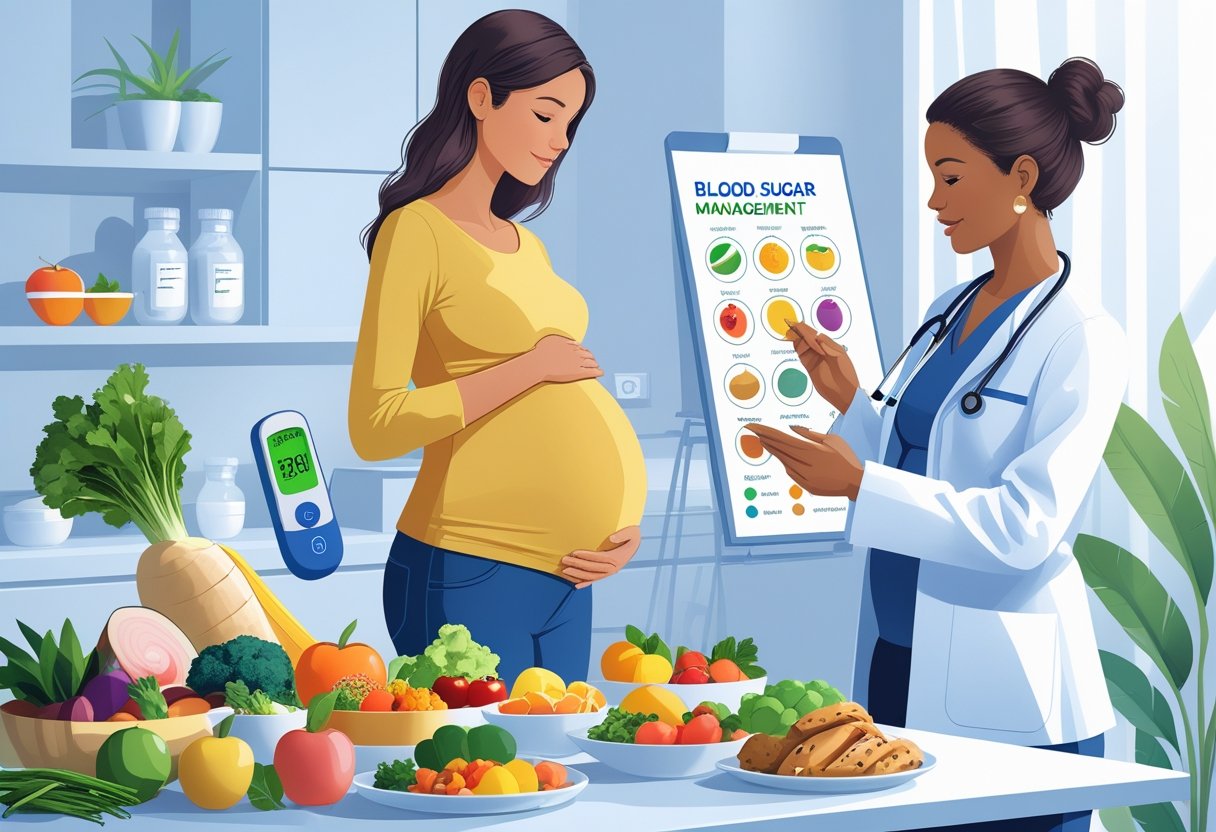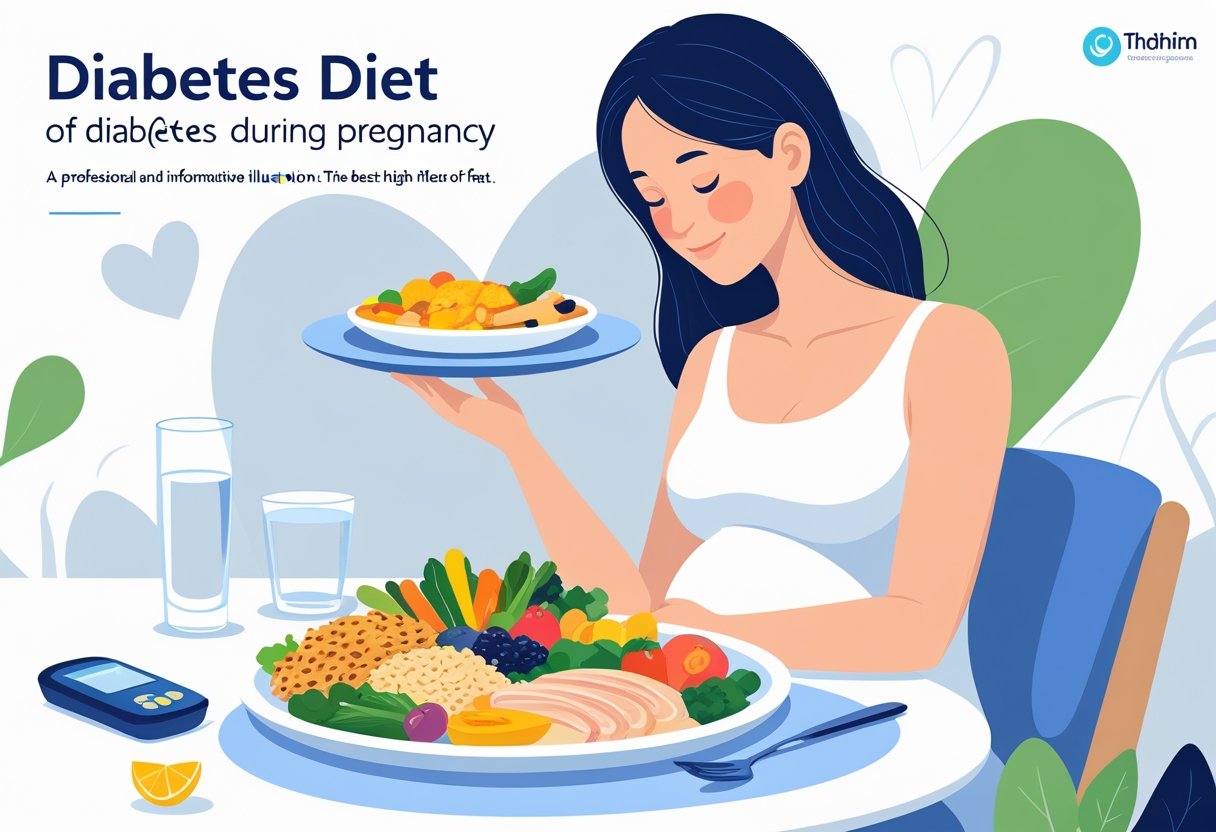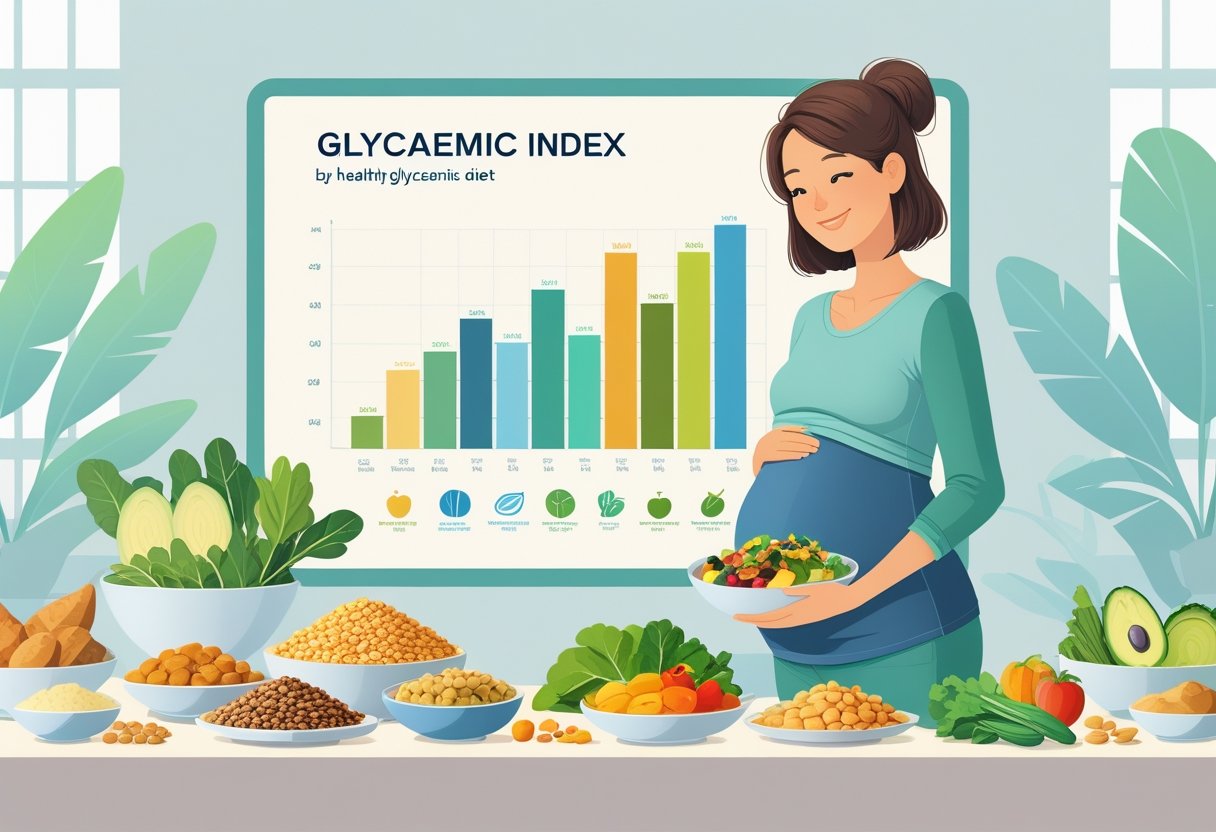Managing diabetes during pregnancy requires careful attention to diet and nutrition to protect both mother and baby’s health. Whether dealing with gestational diabetes or pre-existing type 1 or type 2 diabetes, the foods a woman chooses can significantly impact blood sugar levels and pregnancy outcomes. A well-planned diabetes diet during pregnancy focuses on controlling blood sugar through balanced meals, proper carbohydrate management, and consistent meal timing.

Blood sugar control during pregnancy becomes even more critical as hormonal changes affect insulin sensitivity throughout the nine months. The body’s insulin needs fluctuate, requiring adjustments to eating patterns and food choices. Understanding how different foods affect glucose levels helps expectant mothers make informed decisions about their meals.
Making changes to your diet will help manage blood sugar levels and reduce the risk of pregnancy complications. This comprehensive guide covers everything from understanding the glycemic index to creating practical meal plans that support healthy blood sugar levels while providing essential nutrients for fetal development.
Key Takeaways
- Balanced meals with controlled carbohydrates help maintain stable blood sugar levels throughout pregnancy
- Timing meals consistently and choosing low glycemic index foods prevents dangerous blood sugar spikes
- Working with healthcare providers ensures proper nutrition while managing diabetes complications during pregnancy
Understanding Diabetes in Pregnancy

Diabetes during pregnancy requires careful management to protect both mother and baby. The condition can develop during pregnancy or exist before conception, with each type presenting unique challenges and management needs.
Gestational Diabetes Overview
Gestational diabetes is a type of diabetes that occurs during pregnancy. It usually develops between 24 to 32 weeks of pregnancy and disappears after delivery.
The condition occurs when the placenta makes hormones that prevent insulin from working properly. This leads to higher blood sugar levels than normal.
Risk factors include:
- Age older than 25
- Family history of gestational diabetes
- Heart disease or high blood pressure
- Inactivity or obesity
- Having polycystic ovary syndrome (PCOS)
- Previously delivering a baby weighing nine pounds or more
- Being Asian American, Native American, Black, or Hispanic
Women who develop gestational diabetes have a higher chance of developing it again in future pregnancies. The condition affects blood sugar control and requires dietary changes and monitoring.
Differences Between Types of Diabetes in Pregnancy
Type 1 diabetes exists before pregnancy and requires insulin injections. Women with Type 1 diabetes need to plan their pregnancies carefully with their healthcare team.
Type 2 diabetes also develops before pregnancy but may be managed with diet, exercise, or medication. Some women discover they have Type 2 diabetes during pregnancy testing.
Key differences:
| Type | Onset | Management |
|---|---|---|
| Gestational | During pregnancy | Often diet and exercise |
| Type 1 | Before pregnancy | Insulin required |
| Type 2 | Before pregnancy | Varies by individual |
Blood glucose monitoring increases to 6 times daily for Type 1 and Type 2 diabetes in pregnancy. This includes testing before meals and two hours after eating.
Impact of Diabetes on Maternal and Fetal Health
Diabetes during pregnancy can negatively affect the health of pregnant women and their babies. High blood sugar levels around conception increase the risk of serious complications.
Maternal risks include:
- High blood pressure
- Preeclampsia
- Increased risk of cesarean delivery
- Future Type 2 diabetes development
Fetal and newborn risks include:
- Birth defects
- Stillbirth
- Preterm birth
- Large birth weight (macrosomia)
- Low blood sugar after birth
- Breathing problems
Early pregnancy insulin needs may decrease due to morning sickness and reduced food intake. Later in pregnancy, hormones increase insulin requirements significantly.
Proper blood sugar control before and during pregnancy reduces these risks. Women with diabetes require more frequent prenatal visits and specialized care throughout their pregnancy.
Blood Sugar Management During Pregnancy

Blood sugar control becomes critical during pregnancy as both mother and baby depend on stable glucose levels for healthy development. Proper monitoring and maintaining target ranges help prevent serious complications for both mother and child.
Role of Blood Sugar Monitoring
Regular blood sugar monitoring helps pregnant women track glucose patterns and make necessary adjustments to their care plan. Women with diabetes during pregnancy need to check their blood sugar multiple times daily.
Most doctors recommend checking glucose levels at specific times. These include fasting in the morning, before meals, and one to two hours after eating.
Blood sugar meters provide instant readings that help identify trends. High or low readings signal the need for immediate action. This might include adjusting medication, changing food choices, or modifying exercise routines.
Healthcare providers use these readings to adjust treatment plans. They may change insulin doses or recommend dietary modifications based on the patterns they see.
Glucose Targets in Pregnancy
Fasting glucose levels should stay below 95 mg/dL in the morning before eating. One-hour post-meal readings should remain under 140 mg/dL. Two-hour post-meal levels need to stay below 120 mg/dL.
These targets are stricter than those for non-pregnant adults. The developing baby needs steady glucose levels to grow properly.
| Time of Day | Target Range |
|---|---|
| Fasting | Less than 95 mg/dL |
| 1 hour after meals | Less than 140 mg/dL |
| 2 hours after meals | Less than 120 mg/dL |
Women should work closely with their healthcare team to maintain these levels. Close-to-normal blood sugar control throughout pregnancy reduces risks for both mother and baby.
Consequences of Uncontrolled Blood Sugar
High blood sugar levels during pregnancy can cause serious problems for both mother and baby. The baby may grow too large, making delivery difficult and increasing the risk of cesarean section.
Babies born to mothers with uncontrolled diabetes face higher risks of birth defects. They may also develop low blood sugar right after birth, requiring immediate medical care.
Mothers with poor glucose control face increased risks of preeclampsia and early labor. Pregnancy creates a ketogenic state, putting women with diabetes at higher risk for diabetic ketoacidosis even at lower glucose levels.
Long-term consequences include higher chances of developing type 2 diabetes later in life. The child may also face increased obesity and diabetes risks as they grow up.
Key Principles of a Diabetes Diet in Pregnancy

Managing diabetes during pregnancy requires careful attention to what, when, and how much you eat. Controlling carbohydrate intake and eating balanced meals at consistent times helps maintain stable blood sugar levels for both mother and baby.
Balanced Meal Planning
A balanced meal plan forms the foundation of diabetes management during pregnancy. Each meal should include complex carbohydrates, lean proteins, and healthy fats in the right proportions.
Complex carbohydrates with a low glycemic index prevent blood sugar spikes. Women should choose whole grains, brown rice, and oats over refined options. These foods release glucose slowly into the bloodstream.
Lean protein sources help stabilize blood sugar levels throughout the day. Good choices include:
- Grilled chicken breast
- Fish like salmon or cod
- Tofu and legumes
- Eggs and low-fat dairy
Healthy fats from avocados, nuts, seeds, and olive oil support heart health. These fats also help the body absorb important vitamins needed during pregnancy.
High-fiber foods like vegetables, fruits, and whole grains aid digestion. They also help regulate blood sugar levels naturally.
Regular Meal Timing
Eating meals at consistent times prevents dangerous blood sugar swings. Regular meal timing throughout the day helps avoid fluctuations in blood sugar levels.
Most women with diabetes benefit from eating three moderate meals and two to three small snacks daily. This pattern keeps blood sugar steady between meals.
Skipping meals can cause blood sugar to drop too low, then spike when eating resumes. This creates a dangerous cycle that’s hard to control.
Spacing meals 3-4 hours apart works well for most pregnant women. Snacks should be eaten 2-3 hours after meals to prevent hunger.
Planning meals ahead of time makes it easier to stick to regular eating schedules. Preparing healthy snacks in advance helps avoid poor food choices.
Importance of Portion Sizes
Controlling portion sizes directly impacts blood sugar control during pregnancy. Even healthy foods can raise blood sugar if eaten in large amounts.
Carbohydrate portions need the most attention since they affect blood sugar most. A registered dietitian can help determine the right amount of carbs for each meal.
The plate method provides a simple way to control portions:
- Fill half the plate with non-starchy vegetables
- Use one quarter for lean protein
- Reserve one quarter for complex carbohydrates
Measuring tools like measuring cups and food scales help ensure accurate portions. Over time, women learn to estimate proper serving sizes visually.
Portion control becomes more important as pregnancy progresses. Insulin needs change throughout pregnancy, requiring adjustments to food intake.
Carbohydrates and Glycaemic Index

Managing carbohydrates through glycaemic index awareness helps control blood sugar levels during pregnancy. Low GI foods provide steady energy and better glucose control compared to high GI options.
Choosing the Right Carbohydrates
Pregnant women with diabetes should include one type of starchy carbohydrate at each meal while avoiding large portions. The key is selecting quality carbohydrates that support stable blood sugar levels.
Recommended carbohydrate sources include:
- Whole grain bread and cereals
- Brown rice and quinoa
- Sweet potatoes
- Legumes and lentils
- Oats and barley
These foods contain fiber and nutrients that slow sugar absorption. They help prevent rapid spikes in blood glucose levels after meals.
Portion control remains essential. A balanced plate should include carbohydrates alongside vegetables, protein, and healthy fats. This combination helps slow digestion and improves blood sugar control.
Understanding Glycaemic Index
The glycaemic index measures how quickly a carbohydrate food is broken down into sugar. It shows how much and how fast foods change blood glucose levels.
GI scale ranges:
- Low GI: 55 or below
- Medium GI: 56-69
- High GI: 70 or above
Low GI foods are broken down slowly and cause gradual rises in blood sugar. High GI foods cause rapid spikes and often lead to hunger soon after eating.
The glycaemic index of carbohydrates affects blood glucose readings. Choosing lower GI foods may reduce the speed at which blood glucose levels rise.
Low vs High GI Foods
Low GI foods (55 or below):
- Rolled oats
- Whole grain bread
- Brown rice
- Apples and pears
- Chickpeas and lentils
- Greek yogurt
High GI foods (70 or above):
- White bread
- Instant rice
- Cornflakes
- Watermelon
- Potatoes
- Sugary drinks
Choosing nutritious lower glycaemic index foods like whole grain starchy foods, pulses, fruit and vegetables helps manage diabetes during pregnancy.
Research shows low-glycaemic load diet may reduce macrosomia risk in gestational diabetes. This means babies are less likely to be born too large.
Whole grains consistently rank lower on the GI scale than refined grains. They provide steady energy and help maintain stable blood sugar throughout the day.
Foods to Include for Optimal Nutrition
Women with diabetes during pregnancy need specific foods that provide essential nutrients while helping control blood sugar levels. Fresh vegetables, protein-rich legumes, and calcium-packed dairy products form the foundation of a healthy diabetic pregnancy diet.
Vegetables and Healthy Foods
Non-starchy vegetables should fill half of every meal plate during diabetic pregnancy. These foods provide vital vitamins and minerals without causing blood sugar spikes.
Best vegetable choices include:
- Leafy greens like spinach and kale
- Broccoli and cauliflower
- Bell peppers and zucchini
- Carrots and green beans
These vegetables contain fiber that slows sugar absorption. They also provide folate, which prevents birth defects.
Whole grains like brown rice and quinoa offer steady energy. Fresh fruits in small portions add natural sweetness plus vitamin C.
Lean proteins such as chicken, fish, and eggs help maintain stable blood sugar. They also support the baby’s growth and development.
Legumes: Lentils and Beans
Lentils and beans provide excellent protein and fiber for pregnant women with diabetes. These foods help prevent blood sugar spikes after meals.
Top legume options:
- Black beans and kidney beans
- Chickpeas and navy beans
- Red lentils and green lentils
- Split peas
One cup of cooked lentils contains about 18 grams of protein. This amount meets nearly one-third of daily protein needs during pregnancy.
Beans also supply iron, which prevents anemia. Pregnant women need extra iron to support increased blood volume.
These foods pair well with whole grains to create complete proteins. Try lentil soup or bean salads for satisfying meals.
Dairy: Milk and Yogurt
Low-fat dairy products provide calcium and protein essential for bone development. Balanced pregnancy diets should include dairy foods to support both mother and baby.
Recommended dairy choices:
- Plain Greek yogurt
- Low-fat milk
- Reduced-fat cheese
- Cottage cheese
Greek yogurt contains twice the protein of regular yogurt. It also has probiotics that support digestive health.
Milk provides vitamin D, which helps the body absorb calcium. Choose unsweetened varieties to avoid added sugars.
Pregnant women need 1,000 mg of calcium daily. Three servings of dairy foods typically meet this requirement.
Foods and Drinks to Limit or Avoid
Managing Sugar Intake and Sweets
Managing sugar intake is crucial for controlling blood glucose levels during pregnancy. It’s important to limit consumption of sweets such as candies, cakes, cookies, and pastries, which can cause rapid spikes in blood sugar. Opting for naturally sweet foods like fresh fruits in moderation is a better choice.
Limiting Sugary Drinks and Fruit Juice
Sugary beverages, including sodas, energy drinks, and fruit juices, contain high amounts of simple sugars that can quickly elevate blood glucose. It’s best to avoid these drinks and instead focus on water, herbal teas, or milk to stay hydrated without added sugars.
Considerations for Artificial Sweeteners
Artificial sweeteners may be used as sugar substitutes, but their safety during pregnancy varies. Some, like sucralose and stevia, are generally considered safe in moderate amounts, while others should be avoided. Always consult your healthcare provider before including artificial sweeteners in your diet.
Meal Planning Tips and Practical Strategies
Breakfast Choices and Strategies
Starting your day with a balanced breakfast that includes protein, fiber, and healthy fats can help stabilize blood sugar levels. Good options include whole-grain toast with avocado and eggs, Greek yogurt with nuts and berries, or oatmeal topped with seeds.
Smart Snacking During Pregnancy
Healthy snacks can prevent blood sugar dips and excessive hunger. Choose snacks with a balance of protein and fiber such as a small handful of nuts, sliced vegetables with hummus, or a piece of fruit paired with cheese.
Example Meal and Snack Ideas
- Breakfast: Scrambled eggs with spinach and whole-grain toast
- Snack: Apple slices with almond butter
- Lunch: Grilled chicken salad with mixed greens and quinoa
- Snack: Greek yogurt with chia seeds
- Dinner: Baked salmon with steamed broccoli and brown rice
Additional Considerations for a Healthy Pregnancy
Hydration and Healthy Beverages
Staying well-hydrated supports overall health and helps regulate blood sugar. Aim for plenty of water throughout the day. Herbal teas (without caffeine or added sugar) and milk are also good options.
Physical Activity and Lifestyle Tips
Regular physical activity, as advised by your healthcare provider, can improve insulin sensitivity and help manage gestational diabetes. Activities like walking, prenatal yoga, and swimming are generally safe and beneficial during pregnancy.
Frequently Asked Questions
What foods should I include in a meal plan for gestational diabetes?
Include high-fiber vegetables, lean proteins, whole grains, healthy fats, and moderate portions of low-glycemic fruits. Avoid refined carbohydrates and sugary foods.
How can I manage blood sugar levels through diet during pregnancy?
Focus on balanced meals with controlled portions, eat regular small meals and snacks, limit simple sugars, and choose complex carbohydrates with fiber.
Which fruits are recommended to avoid with gestational diabetes?
Limit high-sugar fruits such as mangoes, grapes, cherries, and ripe bananas. Opt for berries, apples, pears, and citrus fruits in moderation.
What is a suitable seven-day meal plan for someone with gestational diabetes?
A suitable meal plan includes lean proteins, whole grains, non-starchy vegetables, healthy fats, and controlled portions of fruits. Meals are spaced evenly throughout the day with healthy snacks to maintain stable blood sugar.
Can you provide a gestational diabetes-friendly menu for an Indian diet?
Yes. Focus on whole grains like brown rice and millets, lentils and legumes, plenty of vegetables, moderate dairy, nuts, and lean proteins such as chicken or fish. Limit sweets, white rice, and fried foods.
Are there any home remedies that assist in managing gestational diabetes?
While no home remedies replace medical treatment, some natural approaches like regular physical activity, consuming fiber-rich foods, and drinking fenugreek seed water (after consulting your doctor) may support blood sugar control. Always discuss any remedies with your healthcare provider before use.



Pingback: Is Papaya Good for Diabetes: Evidence-Based Benefits and Blood Sugar Impact - Pharma Heals